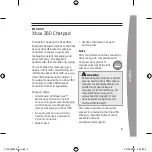
Appendices
January 2023
•
Rev. 0
• Standard Devices User Manual
39
Appendix A: Pinouts
Check the calibration data sheet and pinout for your device.
See
for additional important information about connecting your device to a computer for serial commands. Individual
pinouts available at
. The availability of different output signals depend on the options ordered.
8-Pin Mini-DIN (Default)
Locking Industrial Connector Pinout
Pin Function
Pin
Function
1
Not Connected
Optional: 4–20 mA primary output signal
1
Power In
2
Static 5.12 Vdc
Optional: secondary analog output (4–20
mA, 0–5 Vdc, 1–5 Vdc, 0–10 Vdc) or basic alarm
2
Serial RS-232TX / RS-485(+) output signal (send)
3
Serial RS-232 RX / RS-485(−) Input Signal (receive)
3
Serial RS-232 RX / RS-485(−) Input Signal (receive)
4
Analog Setpoint Input (Controllers)
Remote Tare (Meters and Gauges)
4
Analog Setpoint Input (Controllers)
Remote Tare (Meters and Gauges)
5
Serial RS-232TX / RS-485(+) output signal (send)
5
Ground (common for power, digital
communications, analog signals, and alarms)
6
0–5 Vdc Analog Out
Optional: 1–5 Vdc or 0–10 Vdc output signal
6
Analog Out (voltage or current as ordered)
7
Power In
8
Ground (common for power, digital communications,
analog signals, and alarms)
!
Warning:
Do not connect power to pins 1
through 6, as permanent damage can occur. It
is common to mistake pin 2 (labeled 5.12 Vdc
Output) as the standard 0–5 Vdc analog output
signal. Pin 2 is normally a constant 5.12 Vdc.
Male Connector
Female Connector
1
4
5
6
8
7
3
2
1
4
5
6
8
7
3
2
Male Connector
Female Connector
1
2
3
4
5
6
5
4
3
2
1
6









































